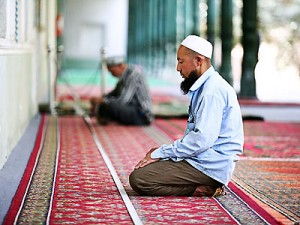Teaching the Quran in Uyghur Autonomous Region
Today’s Zaman, 18 August 2015
By Hasan Kanbolat – Mosques fail to offer enough space for worshippers at regular Friday prayers for Muslims in two prominent cities of the Uyghur Autonomous Region of China: Urumchi and Kashgar. People have to take to the streets and squares without bothering others. The Idkha Mosque in downtown Kashgar is the largest mosque in the region. More than 30,000 people join the Eid prayers performed in the square that also hosts the mosque. The Idkha Mosque was built in 1442 and was enlarged three times. Around 700 people can perform prayers in the closed area of the mosque.
There are 28,000 clerics (24,000 appointed to mosques) officially assigned to the Uyghur Autonomous Region. There are schools teaching lessons on the Quran in the local towns that offer courses lasting two to three months. Graduates of elementary and high schools are admitted to these schools. China has nine years of compulsory education during which no religious courses are offered. There are 10 Quran courses in China. The Xinjiang Quran School is the only officially recognized school for teaching the Quran in Xinjiang Uyghur region in China.
It is also the only school that teaches the Quran in the Uyghur language in China. The hadiths are recited in Arabic but the explanations are in Uyghur. Students study for five years in the school to receive their qualifications and Muslim graduates who are appointed to serve the people are given a monthly allowance. There are 10 different ethnic Muslim groups in Xinjiang and those other than the Kazakhs, Kyrgyz and Huis are able to communicate with each other. The graduates of the school teach the Quran to the public and some work as members of the local popular congress.
The Chinese Religious Affairs Directorate and the Chinese Islamic Affairs Department regulate the appointment of students abroad. Of these, 37 students continued their education in Egypt. The Huis have nine other Quran schools in other parts of China. The Huis teach in the Chinese language. The construction of the Xinjiang Quran School started in 1983 and the school was completed in 1987. It receives financial aid from the state and the Chinese government gave 250 million yuan in 2012 to construct a huge new school that now hosts 300 students and 70 teachers. They train clerics in eight undergraduate and three pre-undergraduate programs. Mainly religious and cultural courses are offered, with cultural courses constituting 3 percent of the curriculum. The cultural classes include ethnic and religious policies.
Uyghur literature, Arab language and literature, and history are also being taught. Seventy percent of the courses are focused on religious studies, which include studying the Quran, recital, tawjeed (rules of recitation), methodology, Islamic jurisprudence, Islamic theology and culture, the life of the Prophet Muhammad and Arabic grammar. Male high school graduates aged between 18 and 22 are admitted to the school in a two-stage exam.
The Xinjiang Quran School is a religious school that trains clerics. They do not admit female students. There are three different types of religious education: clerical school, Quran courses and Quran schools. Women are allowed to receive religious training from their fathers or husbands at home. The school offers help every year for those who would like to perform the pilgrimage in Mecca. The pilgrims have to meet several conditions, including having sufficient financial resources, being healthy and able to travel. Every year, nearly 14,000 people in China travel to Mecca for the pilgrimage. Of these, about 3,500 sign up for the pilgrimage in Xinjiang. Turkish Religious Affairs Directorate President Mehmet Görmez has paid a visit to Xinjiang twice. He was appointed president after he returned from Urumchi. For this reason, it is argued that Urumchi brings good luck.


